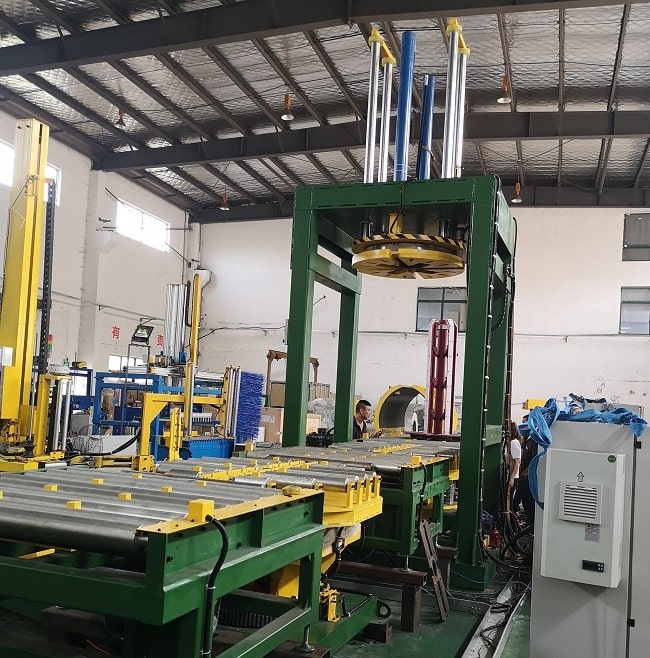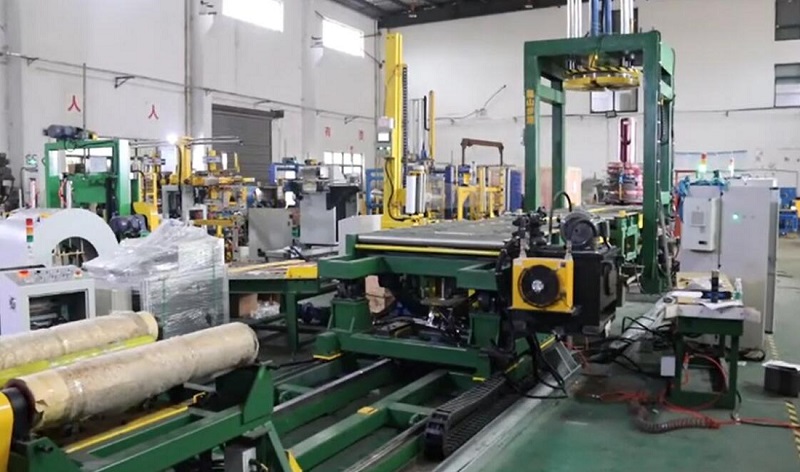Handling and packaging large steel wire coils presents significant logistical and safety challenges in manufacturing environments. An integrated system combining compacting, strapping, and handling functions offers a robust engineering solution. The steel wire coil compressing and rack take-off machine represents such a system, designed to streamline the packaging process for steel wire coils, enhancing both efficiency and operator safety. This article delves into the technical specifications, design considerations, operational workflow, and user experience aspects of this automated packaging line component.
1. System Overview: Integrating Compaction and Handling
This machine serves as a critical node within a comprehensive steel wire packaging line. Its primary function is to receive steel wire coils, often loaded on carriers or racks, compress them to achieve denser packaging and stable handling, securely strap the compacted coils, and then carefully remove the coil from its carrier for subsequent processing or dispatch. The integration of these steps into a single automated sequence minimizes manual handling, reduces cycle times, and ensures consistent packaging quality.
2. Core Components and Technical Specifications
The system's effectiveness relies on the coordinated function of several key sub-assemblies:
2.1 Automatic Compacting Station
- Function: Applies controlled force vertically to reduce the overall height of the wire coil stack on its carrier, ensuring a tight, stable package.
- Mechanism: Typically utilizes a robust hydraulic press system for high compacting forces.
- Control: Force and dwell time are precisely controlled via PLC inputs, adjustable based on wire gauge and coil size.

steel wire packaging 2.2 Wire Coil Strapping Unit
- Function: Applies radial straps (typically PET or steel) around the circumference of the compacted coil while it remains on the carrier.
- Mechanism: Features an automated strapping head that feeds, tensions, seals (usually via friction weld or notch joint), and cuts the strap. Often capable of applying multiple straps at programmed intervals.
- Integration: Works in tandem with the compactor; strapping occurs post-compaction.
2.3 Carrier Take-Off Mechanism
- Function: Lifts the strapped wire coil vertically off the carrier/rack and transfers it to an adjacent roller conveyor or discharge station. This often involves a 90-degree rotation to orient the coil eye horizontally for downstream processes.
- Mechanism: Employs a combination of lifting arms or grippers and a powered rotation system. Movement is typically servo-driven or hydraulically actuated along linear tracks for precise positioning.
- Handling: Designed with non-marring contact surfaces to protect the wire integrity.
2.4 Carrier Handling (Pusher & Recycle Conveyor)
- Function: After the coil is removed, the empty carrier is automatically ejected from the take-off station.
- Mechanism: A pneumatic or electric pusher moves the empty carrier onto a separate conveyor line for return to the coil loading area, maintaining workflow continuity.
2.5 Control System
- Function: Orchestrates the entire sequence of operations, monitors sensors, and provides an interface for operators.
- Components: Typically based on a Programmable Logic Controller (PLC) (e.g., Siemens, Allen-Bradley) with a Human-Machine Interface (HMI) touchscreen panel for parameter setting, diagnostics, and manual control.
Technical Data Comparison (Typical Ranges - Subject to Customization):
| Parameter | Typical Specification | Unit | Notes |
|---|---|---|---|
| Coil Outer Diameter (OD) | 800 - 1500 | mm | Varies with model |
| Coil Inner Diameter (ID) | 500 - 900 | mm | Dependent on carrier design |
| Coil Width / Height | 400 - 1200 | mm | Max height before compaction |
| Max Coil Weight | 1000 - 3000 | kg | System load capacity |
| Compacting Force | 5 - 20 | Tons | Adjustable |
| Strapping Type | PET / Steel | - | Specify strap dimensions |
| Number of Straps | 2 - 6 | - | Programmable |
| Strapping Cycle Time | 15 - 30 | Seconds/strap | Excludes compaction & handling time |
| Take-Off Rotation | 90 | Degrees | Optional, depends on line layout |
| Power Requirements | 480V/3Ph/60Hz (Typical) | V/Ph/Hz | Specify local requirements |
| Control System | PLC with HMI | - |
Note: These values are indicative. Specific machine capabilities depend on the model and customization options.
3. Design and Structural Considerations
Built for industrial environments, these machines prioritize durability and reliability:
- Frame Construction: Fabricated from heavy-gauge structural steel profiles, welded and reinforced to withstand high compaction forces and continuous operation. Finite Element Analysis (FEA) is often employed during design to optimize structural integrity.
- Drive Systems: A combination of hydraulic systems (for high-force compaction), electric motors (for conveyors, rotation, strapping head functions), and pneumatics (for actuators like pushers and clamps) are typically used. Component selection focuses on energy efficiency and maintainability.
- Safety Features: Compliant with relevant safety standards (e.g., ISO, ANSI). Features include physical guarding, safety interlocks on access doors, light curtains at entry/exit points, emergency stop circuits, and clear visual/audible alarms.
- Modularity: Often designed with a degree of modularity, allowing for easier transportation, installation, and potential future modifications or integration with other automated systems like AGVs or robotic handling.
4. Operational Workflow and Efficiency Gains
The automated sequence typically proceeds as follows:
- Coil Entry: A wire coil, loaded onto a carrier/rack, enters the machine's infeed station (often a roller or chain conveyor).
- Positioning: Sensors detect the coil's arrival, and the conveyor positions it accurately within the compacting station.
- Compaction: The hydraulic press engages, applying the pre-set force for the required duration.
- Strapping: The strapping head(s) deploy, applying the programmed number of straps around the coil.
- Transfer to Take-Off: The compacted and strapped coil (still on its carrier) moves to the take-off station.
- Coil Lift & Rotate: The take-off mechanism engages, securely lifts the coil clear of the carrier, and rotates it if required (e.g., 90 degrees).
- Coil Discharge: The lifted coil is placed onto the designated outfeed conveyor or station.
- Carrier Ejection: The empty carrier is pushed from the take-off station onto the recycle conveyor loop.
- System Ready: The machine resets, ready for the next coil.
This automated workflow significantly enhances throughput compared to manual or semi-automatic methods, potentially processing 20-40 coils per hour depending on size and strapping requirements. It reduces direct labor needs for packaging tasks and minimizes risks associated with handling heavy, unstable loads.
5. Maintenance and Operator Experience
While designed for automation, user interaction focuses on oversight and maintenance:
- HMI Interface: Modern systems feature intuitive touchscreen HMIs displaying system status, cycle counts, fault diagnostics, and allowing adjustment of parameters like compacting force, strap tension, and strap positions.
- Strapping Head Maintenance: As noted, replacing a strapping head is a planned maintenance activity. The design facilitates this: releasing electrical connectors, hydraulic/pneumatic lines, and mounting bolts allows the head (approx. weight needing crane assistance) to be swapped relatively quickly (around 15 minutes is achievable for experienced personnel following procedures). This minimizes downtime.
- Routine Maintenance: Includes scheduled lubrication of moving parts (bearings, chains, slides), inspection of hydraulic/pneumatic systems for leaks, sensor checks, and strap coil replenishment. Access points are typically designed for ease of maintenance.
6. Application and Customization
This type of integrated system finds application primarily in:
- Steel wire drawing facilities
- Wire processing centers
- Distribution hubs handling large volumes of wire coils
Customization is key, adapting the machine's dimensions, load capacity, strapping specifications, and control logic to suit:
- Specific coil dimensions and weight ranges.
- Different carrier/rack designs.
- Integration requirements with upstream (coiling lines) and downstream (warehousing, shipping) systems.
- Specific environmental conditions or industry regulations.
Conclusion
The steel wire coil compressing and rack take-off machine is a sophisticated piece of engineered equipment addressing the specific needs of the wire industry. By integrating compaction, strapping, and automated handling, it delivers tangible benefits in operational efficiency, packaging consistency, and workplace safety. Its robust design, reliance on proven industrial automation technologies (hydraulics, PLCs, sensors), and consideration for maintainability make it a valuable asset for manufacturers seeking to optimize their end-of-line packaging processes. Investing in such automation aligns with modern manufacturing principles focused on throughput, quality control, and reduced manual intervention in heavy-duty tasks.


